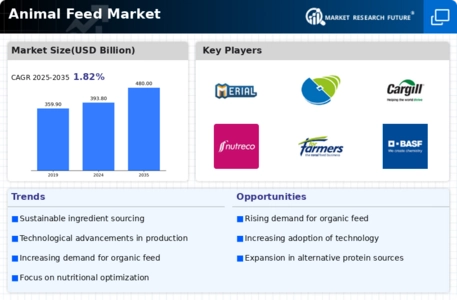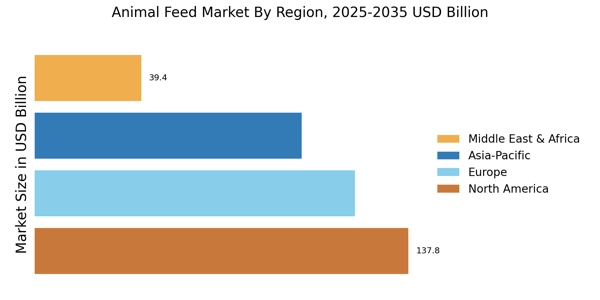Rising Meat Consumption
The increasing demand for meat products is a primary driver of the Animal Feed Market. As populations grow and urbanization accelerates, meat consumption is projected to rise significantly. According to recent data, per capita meat consumption is expected to reach approximately 43 kg by 2025. This surge in demand necessitates a corresponding increase in animal feed production, as livestock require substantial amounts of feed to meet consumer needs. Consequently, the Animal Feed Market is likely to experience robust growth, driven by the need to support livestock farming and ensure food security. The interplay between meat demand and feed supply creates a dynamic environment for producers, who must adapt to changing consumer preferences and regulatory frameworks.
Regulatory Changes and Standards
Regulatory frameworks governing animal feed production are evolving, impacting the Animal Feed Market. Governments are increasingly implementing stringent regulations regarding feed safety, quality, and environmental sustainability. These regulations aim to ensure that animal feed is safe for consumption and does not pose risks to human health or the environment. Compliance with these standards often requires significant investment in research and development, as well as production processes. As a result, companies that adapt to these regulatory changes may gain a competitive advantage in the market. The emphasis on compliance is likely to drive innovation in feed formulation and production techniques, ultimately shaping the future landscape of the Animal Feed Market.
Growing Awareness of Animal Health
The heightened awareness of animal health and welfare is significantly influencing the Animal Feed Market. Consumers are increasingly concerned about the quality of meat and dairy products, leading to a demand for healthier livestock. This trend has prompted farmers to invest in high-quality feed that promotes animal well-being. The market for premium animal feed, which includes organic and non-GMO options, is expanding rapidly, with a projected growth rate of 6% annually. As a result, feed manufacturers are focusing on developing products that enhance animal health, thereby aligning with consumer preferences and regulatory standards. This shift towards health-oriented feed solutions is likely to drive innovation and competition within the Animal Feed Market.
Sustainability and Environmental Concerns
Sustainability is becoming a central theme in the Animal Feed Market, driven by increasing environmental concerns. The livestock sector is a significant contributor to greenhouse gas emissions, prompting calls for more sustainable practices. Feed producers are exploring alternative ingredients, such as insect protein and plant-based sources, to reduce the environmental footprint of animal feed. The market for sustainable feed solutions is expected to grow as consumers demand transparency and eco-friendly products. This shift towards sustainability not only addresses environmental challenges but also aligns with the growing trend of ethical consumerism. As a result, companies that prioritize sustainability in their operations may find new opportunities for growth within the Animal Feed Market.
Technological Innovations in Feed Production
Technological advancements are reshaping the Animal Feed Market, enhancing efficiency and productivity. Innovations such as precision feeding, feed additives, and alternative protein sources are gaining traction. For instance, the integration of data analytics and artificial intelligence in feed formulation allows for tailored nutrition, optimizing animal health and growth rates. The market for feed additives is projected to grow at a compound annual growth rate of 5.5% through 2025, reflecting the increasing focus on improving feed quality. These technological innovations not only improve feed conversion ratios but also contribute to sustainability efforts within the industry, as they help reduce waste and environmental impact.


















Leave a Comment